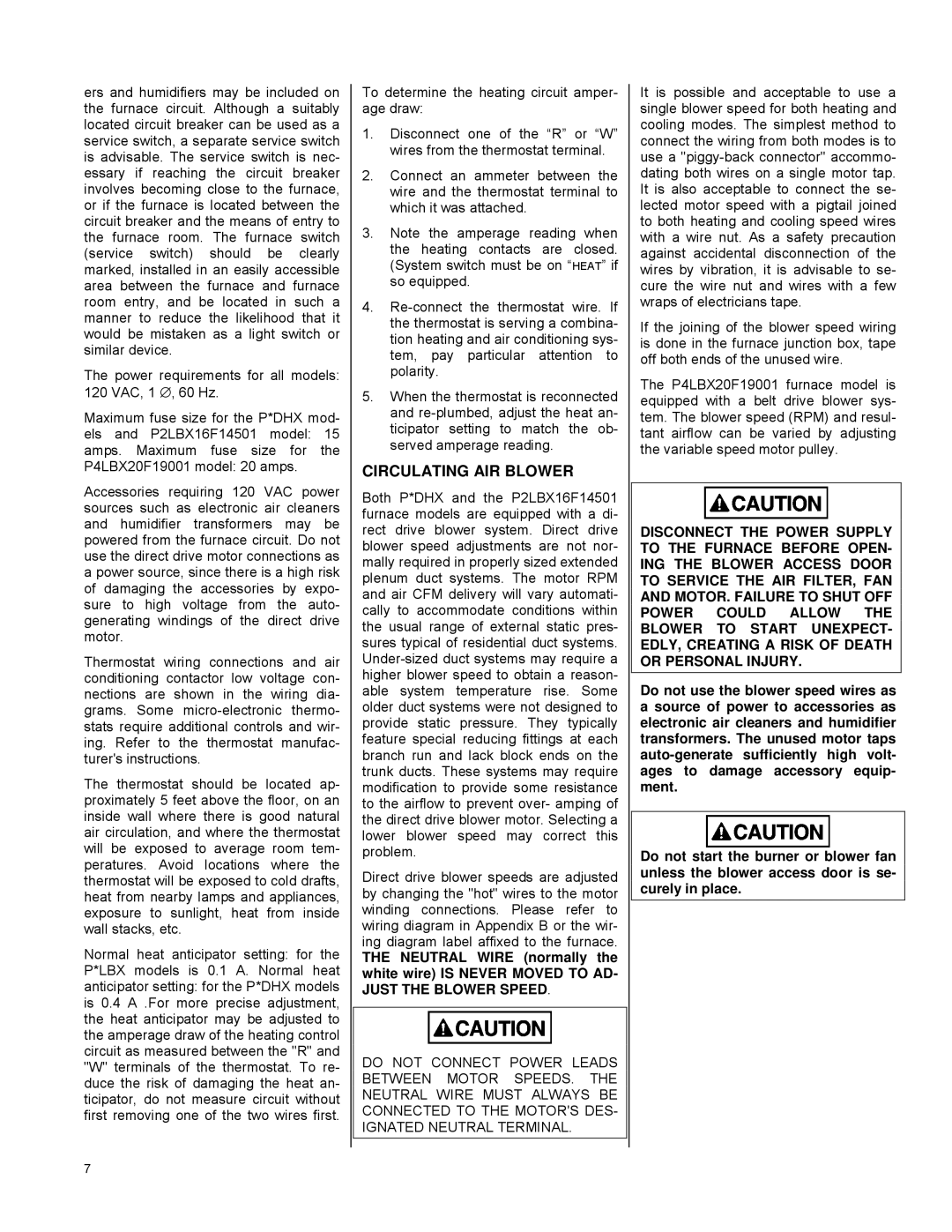ers and humidifiers may be included on the furnace circuit. Although a suitably located circuit breaker can be used as a service switch, a separate service switch is advisable. The service switch is nec- essary if reaching the circuit breaker involves becoming close to the furnace, or if the furnace is located between the circuit breaker and the means of entry to the furnace room. The furnace switch (service switch) should be clearly marked, installed in an easily accessible area between the furnace and furnace room entry, and be located in such a manner to reduce the likelihood that it would be mistaken as a light switch or similar device.
The power requirements for all models: 120 VAC, 1 ∅ , 60 Hz.
Maximum fuse size for the P*DHX mod- els and P2LBX16F14501 model: 15 amps. Maximum fuse size for the P4LBX20F19001 model: 20 amps.
Accessories requiring 120 VAC power sources such as electronic air cleaners and humidifier transformers may be powered from the furnace circuit. Do not use the direct drive motor connections as a power source, since there is a high risk of damaging the accessories by expo- sure to high voltage from the auto- generating windings of the direct drive motor.
Thermostat wiring connections and air conditioning contactor low voltage con- nections are shown in the wiring dia- grams. Some micro-electronic thermo- stats require additional controls and wir- ing. Refer to the thermostat manufac- turer's instructions.
The thermostat should be located ap- proximately 5 feet above the floor, on an inside wall where there is good natural air circulation, and where the thermostat will be exposed to average room tem- peratures. Avoid locations where the thermostat will be exposed to cold drafts, heat from nearby lamps and appliances, exposure to sunlight, heat from inside wall stacks, etc.
Normal heat anticipator setting: for the P*LBX models is 0.1 A. Normal heat anticipator setting: for the P*DHX models is 0.4 A .For more precise adjustment, the heat anticipator may be adjusted to the amperage draw of the heating control circuit as measured between the "R" and "W" terminals of the thermostat. To re- duce the risk of damaging the heat an- ticipator, do not measure circuit without first removing one of the two wires first.
To determine the heating circuit amper- age draw:
1.Disconnect one of the “R” or “W” wires from the thermostat terminal.
2.Connect an ammeter between the wire and the thermostat terminal to which it was attached.
3.Note the amperage reading when the heating contacts are closed. (System switch must be on “HEAT” if so equipped.
4.Re-connect the thermostat wire. If the thermostat is serving a combina- tion heating and air conditioning sys- tem, pay particular attention to polarity.
5.When the thermostat is reconnected and re-plumbed, adjust the heat an- ticipator setting to match the ob- served amperage reading.
CIRCULATING AIR BLOWER
Both P*DHX and the P2LBX16F14501 furnace models are equipped with a di- rect drive blower system. Direct drive blower speed adjustments are not nor- mally required in properly sized extended plenum duct systems. The motor RPM and air CFM delivery will vary automati- cally to accommodate conditions within the usual range of external static pres- sures typical of residential duct systems. Under-sized duct systems may require a higher blower speed to obtain a reason- able system temperature rise. Some older duct systems were not designed to provide static pressure. They typically feature special reducing fittings at each branch run and lack block ends on the trunk ducts. These systems may require modification to provide some resistance to the airflow to prevent over- amping of the direct drive blower motor. Selecting a lower blower speed may correct this problem.
Direct drive blower speeds are adjusted by changing the "hot" wires to the motor winding connections. Please refer to wiring diagram in Appendix B or the wir- ing diagram label affixed to the furnace.
THE NEUTRAL WIRE (normally the white wire) IS NEVER MOVED TO AD-
JUST THE BLOWER SPEED.
DO NOT CONNECT POWER LEADS BETWEEN MOTOR SPEEDS. THE NEUTRAL WIRE MUST ALWAYS BE CONNECTED TO THE MOTOR'S DES- IGNATED NEUTRAL TERMINAL.
It is possible and acceptable to use a single blower speed for both heating and cooling modes. The simplest method to connect the wiring from both modes is to use a "piggy-back connector" accommo- dating both wires on a single motor tap. It is also acceptable to connect the se- lected motor speed with a pigtail joined to both heating and cooling speed wires with a wire nut. As a safety precaution against accidental disconnection of the wires by vibration, it is advisable to se- cure the wire nut and wires with a few wraps of electricians tape.
If the joining of the blower speed wiring is done in the furnace junction box, tape off both ends of the unused wire.
The P4LBX20F19001 furnace model is equipped with a belt drive blower sys- tem. The blower speed (RPM) and resul- tant airflow can be varied by adjusting the variable speed motor pulley.
DISCONNECT THE POWER SUPPLY TO THE FURNACE BEFORE OPEN- ING THE BLOWER ACCESS DOOR TO SERVICE THE AIR FILTER, FAN AND MOTOR. FAILURE TO SHUT OFF POWER COULD ALLOW THE BLOWER TO START UNEXPECT- EDLY, CREATING A RISK OF DEATH OR PERSONAL INJURY.
Do not use the blower speed wires as a source of power to accessories as electronic air cleaners and humidifier transformers. The unused motor taps auto-generate sufficiently high volt- ages to damage accessory equip- ment.
Do not start the burner or blower fan unless the blower access door is se- curely in place.

